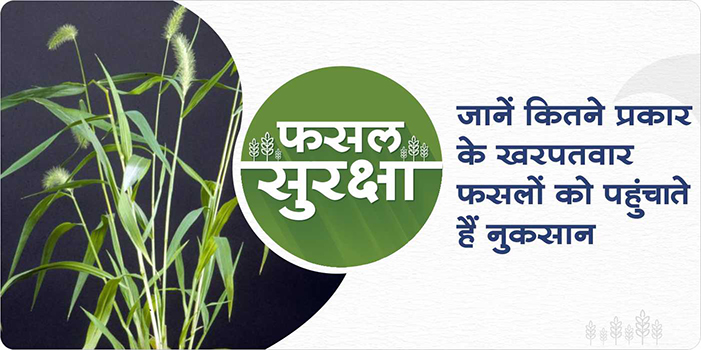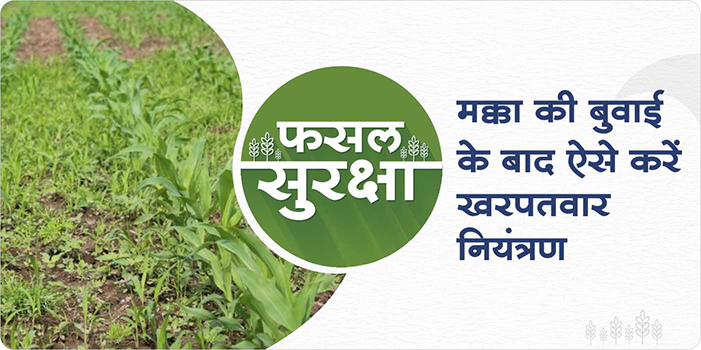How to identify weeds, Know what kind of damage it causes to crops
-
The production of any crop is greatly affected by the outbreak of weeds, pests and diseases, in which maximum 35 to 70 percent loss is due to weeds only. Weeds compete with the crop for natural resources such as light, space, water, air as well as nutrients, causing a huge reduction in yield.
-
Due to the high infestation of weeds, the outbreak of diseases in the crop is also very high. There are three types of weeds in the crop.
-
Narrowleaf / monocotyledon weed: The leaves of the weeds of the grass family are thin and long and parallel stripes are found on these leaves. It is a monocotyledonous plant such as Sanwa (Echinochloa colona) and Kodon (Eleusine indica) etc.
-
Broadleaf / Dicotyledonous weeds: The leaves of this type of weeds are often broad, it is mainly dicotyledonous plants such as choti and badi doodhi, phulkia, diwalia, bokhana, jangali choulai (Amaranthus viridis), safed murgh ( celosia argentea), jangali jute (Corchorus acutangulus)
-
Annual weed: The leaves of this family of weeds are long and the stem is solid with three edges. Tubers are found in the roots, which help in collecting food and giving birth to new plants such as doob, motha (Cyperus rotundus, Cyperus species) etc.
-
The crop yield is greatly affected due to the weeds, the nutrients given to the crop are also absorbed by the weeds. Infestations of the weeds cause more damage to the crop. Generally, weeds use up to 47% of phosphorus, 50% of potash, 39% of calcium and 34% of magnesium available to crops. Due to which the yield of the crop decreases. Due to these weeds, the outbreak of fungal diseases and pests on the crop is also very high.
ShareWith the sowing of the crop, connect your farm with the My Farm section of Gramophone app and keep on getting the exact advice and solutions related to smart agriculture throughout the crop cycle. Share this article with your friends with the share button below.
What were the prices of onions in Indore Mandi on July 10?
Know through video what was the market price of onions in Indore’s mandi today i.e. on 10th July?
Video Source: YouTube
ShareNow sell your crops like garlic and onion at the right rate sitting at home with Gramophone’s Gram Vyapar, Connect with trusted buyers yourself and add your farmer friends as well.
In this scheme, pay the premium once and get a monthly pension of Rs 12000
LIC’s Saral Pension Plan is a single premium plan in which you can get a fixed pension amount throughout your life by paying premium only once. This scheme has been started by Life Insurance Corporation of India on 1st July 2021.
You can buy this scheme offline or online from the official website of www.licindia.in. The minimum annuity under this pension plan is Rs 12000 per annum. There is no maximum purchase price limit in this plan. The scheme is available for the age group of 40 to 80 years. To get the benefit of monthly pension, you have to contribute at least Rs 1000. For quarterly pension, this amount is Rs 3000.
Source: Navbharat Times
ShareKeep reading Gramophone articles daily for important information related to your life. Share this article with your friends by clicking the share button below.
Control of leaf spot disease in Soybean Crop
-
The symptoms of this disease first appear in the densely sown crop, at the lower parts of the plant. The diseased plants show symptoms like leaf spots, leaf blight or drop of leaves.
-
Leaves appear as unusual yellow spots, which later turn brown or black and the entire leaf is scorched.
-
Brown spots also appear on petiole, stem, and pods. The pods and stem tissue after infection become brown or black in color and shrink.
-
In the presence of moisture, white and brown colored formations appear on the diseased parts of the plants.
-
To prevent this disease, chlorothalonil @ 400 gram /acre or carbendazim 12% + mancozeb 63% WP @ 300 gram/acre or Kitazin @ 200 ml/acre
-
Spraying Trichoderma viride @ 250 gram/acre + Pseudomonas fluorescens @ 250 gram / acre as a biological product.
ShareWith the sowing of the crop, connect your farm with the My Farm section of Gramophone app and keep on getting the exact advice and solutions related to smart agriculture throughout the crop cycle. Share this article with your friends with the share button below.
Weed management after sowing in maize crop
-
Irrespective of the crop, the abundance of weeds leads to a decrease in yield. Like all other crops, the maize crop also suffers from severe yield loss due to weeds. It is very important to control weeds in time. If you are cultivating maize.
-
Mechanical method of weed management in maize crop: Weeding and hoeing have a special role in the cultivation of maize. With this, weeds can be controlled well. For this, the farmer cultivating maize should do 2 to 3 times weeding and hoeing in maize. Take special care that weeding should never be done deeper than 4 to 5 cm. This is because if deep hoeing is done, it can damage the root of the crop or it can cut the roots. First weeding is done after 15 days of sowing and second weeding is done after about 40 days.
-
Weed control in 1 -3 days:- On the second or third day of sowing, weeds are destroyed by using weedicide before germination. Weeds growing in maize are generally annual grasses and weeds with narrow and broad leaves. The following weedicides can be used in maize.
-
Spraying of Pendimethalin 38.7 @ 700 ml/acre (after 1 to 3 days) or Atrazine 50% WP @ 500 g/acre (after 3 to 5 days) should be done. Do not use atrazine if pulse crops are grown as intermediate crops in maize. Instead, use pendimethalin only.
ShareWith the sowing of the crop, connect your farm with the My Farm section of Gramophone app and keep on getting the exact advice and solutions related to smart agriculture throughout the crop cycle. Share this article with your friends with the share button below.
Heavy rain likely in central India, know where it will rain
There is a possibility of heavy monsoon rains in most areas of Central India. The wait for monsoon is about to end in other areas as well. There is a possibility of heavy rain in many states of North West India including Delhi. Monsoon rains will intensify in most states of the country from July 11. The monsoon deficit which was being felt till now will gradually be fulfilled and crops are also likely to get relief.
Video Source: Skymet Weather
ShareBe sure to visit the Gramophone app daily for information on weather forecasts. Share this article with your friends by clicking the share button below.
What are the prices of crops in different markets in Madhya Pradesh on 9th July?
Market |
Crop |
Minimum |
Maximum |
Ratlam_(Namli Mandi) |
Wheat Lockwan |
1666 |
1765 |
Ratlam_(Namli Mandi) |
Yellow Soyabean |
6500 |
7400 |
Ratlam_(Jaora Mandi) |
Makka |
1571 |
1687 |
Ratlam_(Jaora Mandi) |
Urad |
3251 |
5980 |
Ratlam_(Jaora Mandi) |
Soyabean |
7000 |
7550 |
Ratlam_(Jaora Mandi) |
Wheat |
1650 |
2120 |
Ratlam_(Jaora Mandi) |
Chana |
4121 |
4600 |
Ratlam_(Jaora Mandi) |
Masur |
5200 |
5700 |
Ratlam_(Jaora Mandi) |
Dhaniya |
5000 |
6500 |
Ratlam_(Jaora Mandi) |
Methi |
5001 |
7200 |
Ratlam_(Jaora Mandi) |
Alsi |
6000 |
7201 |
Ratlam_(Jaora Mandi) |
Sarso |
6101 |
6401 |
Ratlam_(Jaora Mandi) |
Dollar Channa |
4501 |
8000 |
Ratlam_Namli Mandi |
Garlic |
1500 |
9801 |
Ratlam_Jaora Mandi |
Onion |
700 |
2101 |
Ratlam_Jaora Mandi |
Garlic |
2001 |
9600 |
Ratlam_Apmc |
Onion |
850 |
2142 |
Ratlam_Apmc |
Garlic |
1100 |
8401 |
Ratlam_(Sailana Mandi) |
Soyabean |
6800 |
7471 |
Ratlam_(Sailana Mandi) |
Wheat |
1600 |
2421 |
Ratlam_(Sailana Mandi) |
Chana |
4540 |
4699 |
Ratlam_(Sailana Mandi) |
Rayada |
5501 |
5811 |
Ratlam_(Sailana Mandi) |
Pea |
2402 |
4570 |
Ratlam_(Sailana Mandi) |
Medhi Dana |
5700 |
5700 |
Ratlam_(Sailana Mandi) |
Masur |
4700 |
5291 |
Now sell your crops at the right rate sitting at home with Gramophone’s Gram Vyapar, Connect with trusted buyers yourself and add your farmer friends as well.
ShareWhat were the prices of onions in Indore Mandi on July 9?
Know through video what was the market price of onions in Indore’s mandi today i.e. on 9th July?
Video Source: YouTube
ShareNow sell your crops like garlic and onion at the right rate sitting at home with Gramophone’s Gram Vyapar, Connect with trusted buyers yourself and add your farmer friends as well.
Announcement to give up to Rs 200 per quintal on milling of paddy
The solution to the problem arising in the milling process of paddy purchased from farmers on support price was taken out in the cabinet meeting chaired by Madhya Pradesh Chief Minister Shivraj Singh Chouhan recently. Let us inform you that in the Kharif marketing year 2020-21, 37 lakh 26 thousand meters were purchased from farmers in the state on support price. Tons of paddy to be milled.
With the aim of speeding up the milling process, the rate of milling in the state is Rs 50 per quintal along with the upgradation amount, according to various options of delivery of rice to Madhya Pradesh State Civil Supplies Corporation and Food Corporation of India, only for Kharif marketing year 2020-21 Rs. 50 for milling. It was decided to give up to Rs.200 per quintal from Rs. It was also decided in this meeting that milling work would also be done by the millers of the bordering states.
Source: Krishak Jagat
ShareFor information related to beneficial government schemes related to agriculture and farmers, read the articles of Gramophone daily. Don’t forget to share this article with your friends using the share button below.









